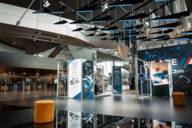
From 5 to 9 September, leading scientists, including three Nobel laureates, came together at Graphene Week 2022 to share the latest insights in graphene research.
500 delegates, from leading researchers to industry representatives from all over Europe, met in Munich from 5 to 9 September 2022 for the "Graphene Week 2022". Their common interest: Graphene and other 2D materials. As a two-dimensional material made of carbon atoms, the researchers believe graphene will play a leading role in the current technology revolution - whether in semiconductor production, sensor technology, photonics, medical technology, surface chemistry, energy generation and storage or telecommunications. Resource conservation and greater sustainability are just two of the keywords that make graphene an attractive material for the future.
The Graphene Flagship is the largest collaborative research project with more than 170 partners in the EU. The scientific leaders of the event were Professor Georg Düsberg from the University of the Bundeswehr München (University of the Federal Armed Forces) and Elmar Bonaccurso from Airbus Group. The conference was the perfect opportunity to exchange ideas, promote new technologies and applications, establish contacts and foster collaboration between scientists worldwide.
Andre Geim from the University of Manchester and Konstantin Novoselov from the National University of Singapore, both not only pioneers in graphene research but also 2010 Nobel Prize winners in physics, presented their latest findings to their colleagues from academia and industry. Klaus von Klitzing, who was awarded the Nobel Prize in Physics back in 1985 and whose research laid important foundations in the fields to be discussed here, was also present at the conference as a discussion partner.
The opening lecture of the conference was given by Andre Geim on "Empty 2D space and its exotic properties". Among the many other high-profile speakers were Acelya Yilmazer from the University of Ankara, who spoke about graphene and 2D materials in antiviral research, and Paulo Lage from Airbus in the Netherlands, who spoke about graphene for lightning protection in CFRP aircraft. However, the innovations presented also included the treatment of drinking water and the fight against viral infections in view of new impending pandemics.
Due to its outstanding properties, graphene can not only form new forward-looking compounds with other materials, but also interact with the nerve cells of the human body. What was just presented as a finding from biomedical research in a lecture could one day make new medications and therapies possible. Basically, graphene research is currently in transition from the laboratory to the application areas. This was also signalled by Graphene Week 2022, which heralded the 10th project year of the Graphene Flagship. This year, the people, organisations and achievements of the Graphene Flagship will enter a new phase of visibility - and the Munich conference marked the beginning.
For Munich, the conference was an exceptionally good opportunity to once again show itself as a representative congress location. And indeed, in addition to the top-class conference, Munich as a MICE destination was also well received by the participants. After all, the venue, BMW Welt, with its impressive and futuristic architecture, is already a real eye-catcher - and an innovative building.
The roof of BMW Welt, for example, is its own little power plant: it is covered with 16,000 solar cells, is completely flat and was designed to resemble a cloud. The open architecture and glass façade bring a lot of light into the rooms and open the building up to its surroundings. The auditorium served as a perfect lecture hall for the Graphene Congress. During the breaks, participants used the outdoor terrace on the upper floor to get some fresh air and enjoy the view.
Since the organisers of the Graphene Flagship are based at Chalmers University of Technology in Gothenburg, Sweden, they had to look for partners in Munich. They found them not only at the University of the Bundeswehr and at Airbus, but also at BMW Welt and at the TimeChange agency, which helped with the run-up and organisation of the conference. The City of Munich also supported the event and warmly welcomed its international guests: In the city centre at the Stachus as well as in Neuhauser Straße, flags with the inscription "Munich welcomes Graphene Week" had been specially put up for the congress.
The opening evening of Graphene Week 2022 took place at the Munich Künstlerhaus on Lenbachplatz, where the Munich organising committee with the scientific directors Georg Düsberg and Elmar Bonaccurso welcomed the guests. Another highlight for the visitors from Germany and abroad was the Bavarian dinner on 8 September in the traditional Augustinerkeller. With live music by the Bavarian band "The Happy Bavarians", contacts were made or intensified with the best graphene researchers in the world and, of course, one or two litres of beer were drunk.
Graphene currently covers a broad spectrum of interest and was accordingly covered by the conference - from basic and applied research to innovation and industry. The most important topics in this field of science include growth, processing and transfer of graphene, electronics, energy generation and storage, spintronics, sensors, nanomedicine, composite materials and health and safety.
Katrin Habenschaden, Deputy Mayor of Munich, and Prof. Merith Niehuss, President of the University of the Federal Armed Forces Munich, were impressed by Graphene Week. "This year, the scientists, organisations and achievements of the Graphene Flagship will enter a new phase of visibility - and this conference marks the beginning of it," Niehuss said in her welcome address.